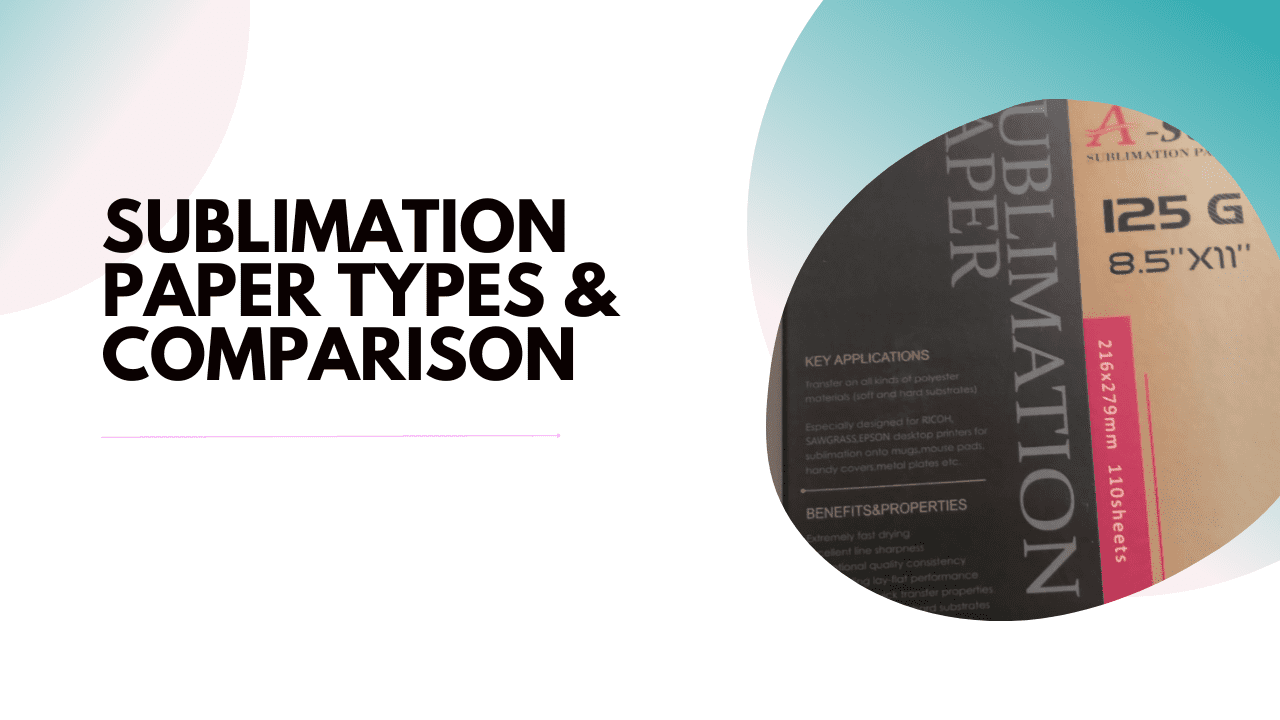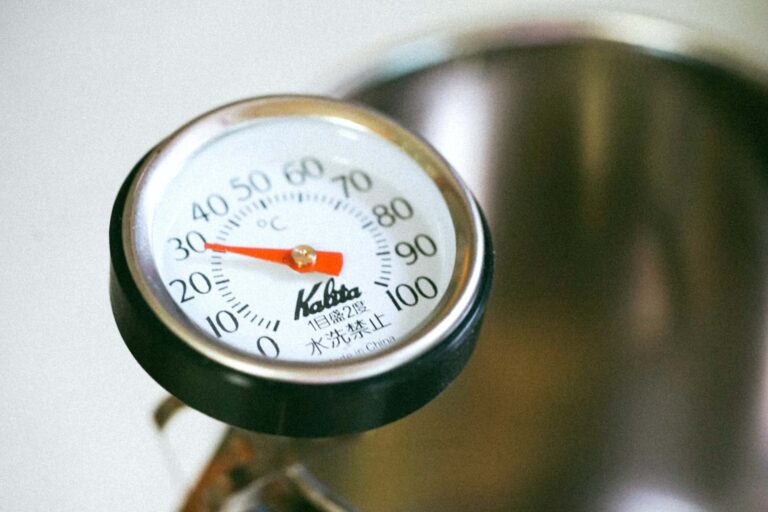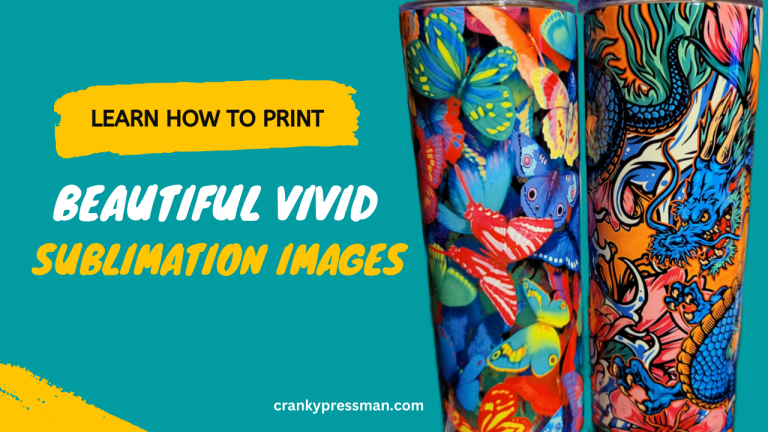What is Sublimation Paper – A Complete Overview
After your sublimation printer is set up and ready, you need to pick a befitting sublimation paper to print the designs. But what do I need sublimation paper?
Why can’t I use the normal copy paper I have lying around? These were the exact questions I had after hearing the term sublimation paper.
You can only do sublimation printing by using the sublimation paper for your designs. As a beginner, you may fancy saving money by using copy paper but will be heavily disappointed with the results.
In this post, I will explain how the sublimation process works and why you need a special type of paper for this craft. In addition, you learn about the paper types, popular paper brands, and a detailed comparison among them. So, let’s begin.
Sublimation Paper 101: What is it?
In simple words, the sublimation paper is the link between your creative designs and them being placed on your choice of surface.
Let’s imagine diving back into the wonderful realm of sublimation. To create beautiful designs on various sublimation blanks, you would first need a sublimation printer, which in turn would require sublimation paper. The paper isn’t any other paper you would see.
Sublimation paper is coated with a chemical. A special concoction that does many things like absorbing the sublimation ink, helping the ink turn into a gaseous substance in contact with heat, and eventually facilitating the transfer of the now-gas ink inside the choice of sublimation surface or blanks. Sigh, that’s a lot of heavy lifting for a paper.
- The paper works when you simply print the design onto it using the printer (not a lot different than your usual printing job).
- Once done, you just need to place it on your choice of surface (t-shirt, mug, etc.), transfer the right amount of heat (no, blowing won’t work), and, eureka, the design will show up on the surface.
But that’s an overly simplistic version of how the sublimation paper works. To know more, check out our detailed post on “How to use Sublimation Paper.” Let us focus on knowing more about what a sublimation paper (the creative canvas) is.
However, it doesn’t work with cotton fabric and other natural fabrics.
Even if you print the design on cotton, it will appear less vibrant. After a single wash, the colors will fade even more because of the ink’s inability to bind with natural fabrics.
But what about a normal paper? Will it work if you use a thick one like the sublimation paper?
Well, no. A copy paper cannot substitute a sublimation paper because it lacks the polyester layer to hold ink. When you print the design on it, the paper won’t absorb most of the ink.
When you attempt to press the design, it will appear more faded than usual. So, refrain from using copy paper because you will waste your expensive sublimation ink for saving a few bucks.
Remember that the end goal is to print vivid designs on fabric and other materials, which will make the end product eye candy.
Attributes of a Good Sublimation Paper
In my opinion, the criteria to judge a decent sublimation paper is based on the following attributes:
1. Thickness
Paper thickness is denoted with GSM, which stands for grams per square meter. You can use it to measure the paper weight and will notice this on the box of every paper manufacturer.
For sublimation transfer, a 100 GSM or more thickness is preferable because it can absorb more ink.
Compared to regular copy paper, sublimation paper is 150 percent thicker.
A copy paper has a thickness of 70 – 80 GSM, while you will find Sublimation papers with 100-140 GSM thickness.
2. Transfer Rate
Transfer rate denotes the extent to which a sublimation paper can transfer the ink to the target fabric. Go for anything with a transfer rate of 98 percent or higher if you want your designs to pop out on the fabric.
3. Fast Drying
After you print the design on paper, it takes 30 seconds to a couple of minutes to dry the ink. If you try to press the design before drying the ink, it will smudge. So, a sublimation paper with fast drying feature can save much of your time and help print more designs.
Now, you know what to look for in a sublimation paper brand. But do these factors guarantee a pristine output?
Well no. The final sublimation result will still depend on other factors, such as printer settings, ink brand, heat press temperature, pressure, time duration for sublimation fabric, and more.
Which side of the sublimation paper is meant for you?
Ahoy, sublimation enthusiasts! It’s time to get back to the basics. I shall now help you find which side of the sublimation paper to use for printing. And if that looks like an underwhelming discussion, hold on till you read through this section.
First of all, there are no obvious imprints on a sublimation paper. Nothing is numbered even. All you need is to trust your vision.
Well, printing the design on the wrong side won’t let you access the chemicals. The design transferred to the surface (even called the substrate) might blur out or, worse, might not even show up. Hence, locating the right side to print is necessary, especially if you are just starting out with sublimation printing.
To locate the right side, look for a clear watermark, something that most sublimation papers have. But what if there is no watermark? Fret not; I have got you covered.
- Try out the smear test. Here is how it works. And no, you don’t need to smear any fancy substance on the paper. Instead, you simply need to smear a bit of sublimation ink on the top corner of the paper.
- Once done, you can heat press that side of the paper onto a dummy surface — say, a blank piece of fabric. If the image is clear, then you have smeared the ink on the right side.
- And if the print comes out to be blurry, it’s time to test the other side.
Still haven’t purchased the heat press! No worries if the ink smudges a bit; you have located the right side. On the wrong side, the ink will simply sit and not smear.
Not interested in the “smear trick”? Well, there is another way.
Look for the side that’s brighter or even glossy. This would be the side that’s chemically coated and needs to be face up while you print.
If you have a paper stack to work with, spare some time and mark the right side with a small arrow of sorts. This will save you time once you start printing in bulk.
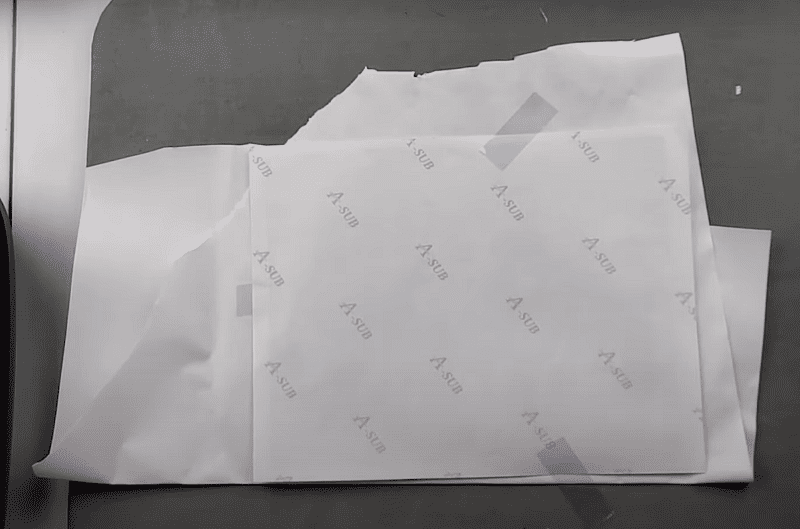
Another nifty strategy to avoid side-locating errors is to read through the instructions provided with the sublimation paper pack. Like ASUB papers come with clear instructions and watermarks.
Sublimation Paper and Ink Choices
Alrighty, it’s now time to shift attention to inks. The juice that powers your sublimation paper. While I will have a separate piece on sublimation inks, I thought discussing inks briefly would make sense.
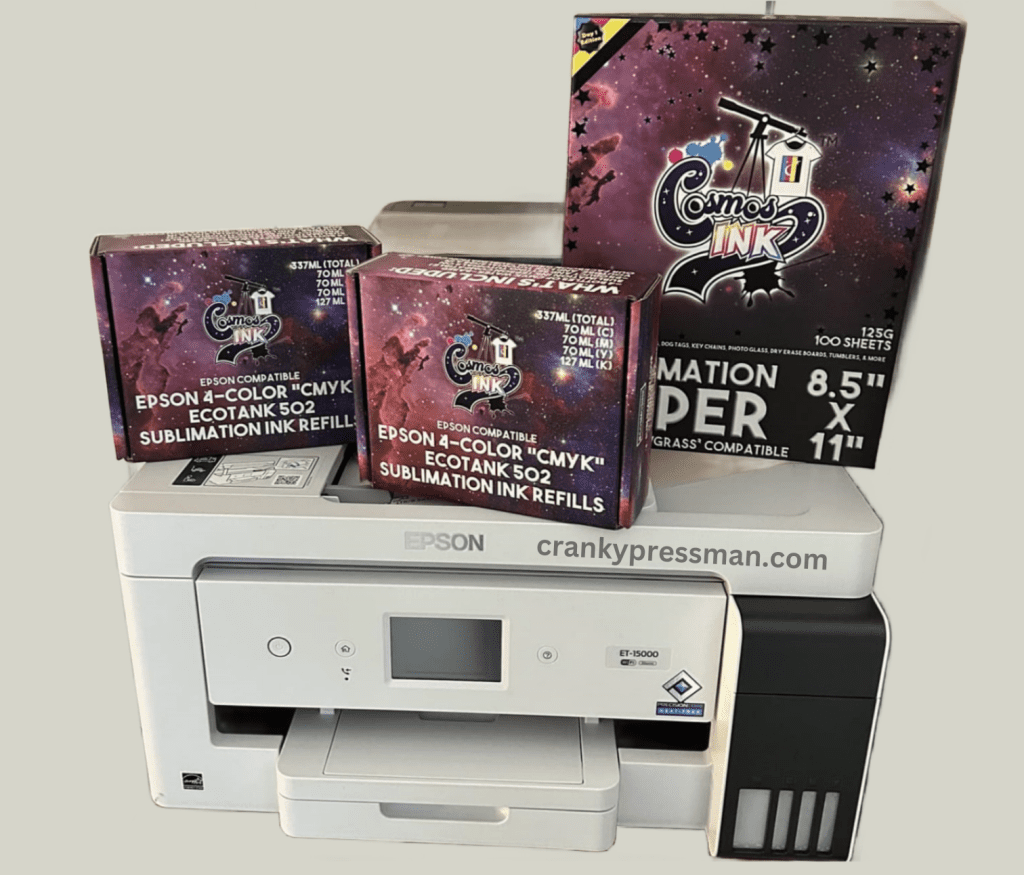
Just a note: the sublimation link is the secret sauce to add some pomp to your designs. You are better off getting the best ones like cosmos ink.
As for the concept, the ink turns from solid (on paper) to a special kind of gas that becomes a part of the fabric or the product you want to work on. As for the types, you can choose between:
- Dye-based;
- Pigment-based.
While the former works best on hard surfaces — ceramics and hard fabric- pigment-based inks are meant for fabrics loaded with cotton or highly porous.
Yet, the type of ink also depends on the type of paper you want to use. There are high-release, low-release, tacky, adhesive, and multi-purpose sublimation papers to choose from.
Confused as to what works for what. Here is a quick rundown:
- High-release: ideal for polyester
- Low-release: ideal for metal, glass, and ceramics
- Tacky: prevents paper shift and is ideal for printing on phone cases, tiles, and mugs.
- Adhesive: it comes with a sticky back and is meant for mouse pads.
- Multi-purpose: meant for soft and hard substrates and can serve multiple purposes.
Which sublimation paper brand is the best?
Honestly, that is a tough question to answer. I could pick a random paper brand and tell you this will get marvelous sublimation results, but that isn’t the case.
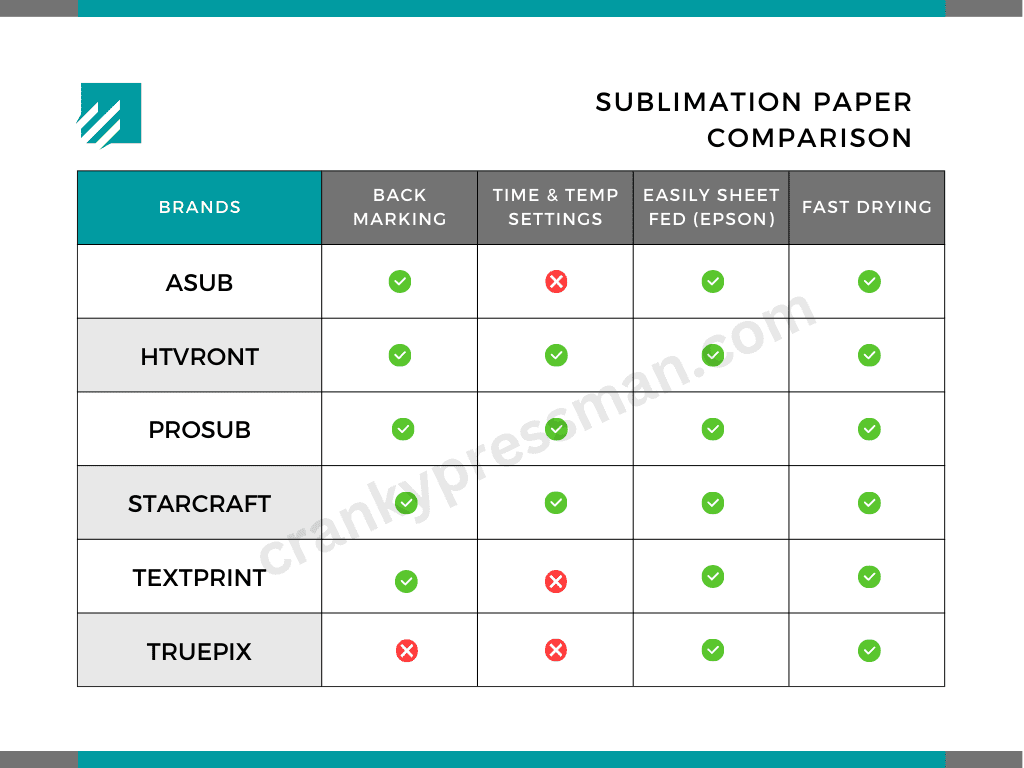
I have tried papers from A-SUB, Sawgrass, Hiipoo, Epson, StarCraft, and PROSUB.
If you use a Sawgrass sublimation printer, get the official sublimation paper, which will absorb the Sawgrass ink without any issue. Since it is 120 G paper, it can retain a lot of colors.
For converted Epson printers, you can use A-SUB 125G paper, which is the maximum available thickness and thus is an excellent absorbent of the sublimation ink.
But several craft enthusiasts blame the A-SUB for not transferring all the color to the fabric. It is an issue that I also have noticed on the designs made using A-SUB. They look dull compared to TruePix or StarCraft.
Do you understand my dilemma here? There is no perfect sublimation paper. But if you want to avoid messing up, go with the official ones from your sublimation printer brands.
If you have a converted printer, you can use the combination of sublimation ink and paper from the brand for the best results.
Some printers cannot use thick sublimation paper, so ensure that beforehand, or they won’t be usable.
Sublimation Paper vs. Heat Transfer Paper
Sublimation is converting a solid ink to gas and etching it on the substrate. But it has a limitation – it can only work with light-colored fabrics.
The result will be disappointing if you try to print a sublimation design on a dark-colored material.
Heat transfer paper also uses heat to transfer the ink, but you can use it to print on dark-colored substrates like black fabrics.
- Firstly, you must print the design on transparent heat paper and transfer it to adhesive paper.
- Afterward, you can emboss it on the fabric using a heat press.
But sublimation transfer is a good choice. Since the ink is converted to gas and then attached to fabric fibers, it blends with the fabric.
So, the design won’t come out after a few washes and will not crack it break if you want to print on polyester and other synthetic substrates that have light colors.
For sublimating on dark shirts, you have to use heat transfer paper.
Sublimation paper vs. other paper types: which one wins
First of all, it isn’t recommended to use any other paper for sublimation printing. But if your neighbor (who doesn’t want you to succeed with sublimation) recommends other papers like Parchment or even DTF, here is a quick segment that you can read them out loud:
- DTF paper: suitable for printing logos and text.
- Transfer paper: suitable for printing on dark color substrates like black t-shirts and cotton. But not for sublimation.
- Heat transfer paper: mostly for blended fabric if you want the design to simply stick. Not for sublimation.
- Regular paper: only for notes, sketches, and documents.
- Parchment paper: meant for baking and cooking.
So the answer is no. Only a sublimation paper is good enough for sublimation.
And that’s not it. If you are new to sublimation transfer, the idea is to experiment and have fun with your projects.
Wrap-up
To sum up, the things we talked about, you need to locate the right paper, the right side to print, pre-treat the surface to avoid sticking, and optimize the heat press for temperature and pressure. This way, you can make the most out of your sublimation setup.
And even though the sublimation paper is the most critical part of your sublimation project, you need to supplement it with the right type of ink to get the best out. With these strategies and some practice, you should become a Sublimation pro in virtually no time. Go and start unleashing creativity right away.
FAQs
You can locate the right side of a sublimation transfer paper by initiating a smear test or by checking for the brighter or rather, the whiter side of the same. If you have plans of doing bulk printing work, I would recommend marking the right sides of the entire pack with an inconspicuous mark.
Can I use Regular Ink on Sublimation Paper?
No, you can never use regular ink with sublimation paper. The entire concept is to use ink that activates the special coating of the paper and turns it into gas once attached to the substrate.
Your sublimation paper might be sticking to the tumbler due to incorrect temperature or even the wrong pressure settings. Or, the paper you are using might not be right.
A parchment paper cannot be used for sublimation. It is mostly for baking and cooking and is not equipped enough to handle the pressure and even the temperature requirements specific to sublimation.
No, you cannot use DTF or Direct to Film paper for sublimation as it is primarily meant for transferring designs to a thin film, which can then later stick to the substrate. This type of paper is suitable for logos and text bits only.
No. Sublimation paper absorbs ink and transfers the design onto the fabric when heat is applied. Heat transfer paper works on a similar concept, but it is transparent. First, you print the design on heat transfer paper; then, you transfer the design to adhesive paper using a heat press. Lastly, use the heat press again to put the design on the fabric. So, it adds a method to the whole process.
No. You cannot use a regular printer and must buy a sublimation printer or convert an inkjet printer into a sublimation printer. Note that inkjet printers with a thermal head cannot work for your sublimation project. Only the ones with Micro Pizeo heads work, but you can find a cheap Epson inkjet printer and convert it into a sublimation printer.
Sawgrass TruePix paper is a widely used paper for Sawgrass brand printers. However, if you use a converted printer, go for StarCraft or PROSUB sublimation paper. Both of these have excellent transfer capabilities and absorb ink quite well.
No. Cricut only makes ready-to-print templates that you can print on a fabric or material using a heat press. They do not produce or sell sublimation paper of any variety.

